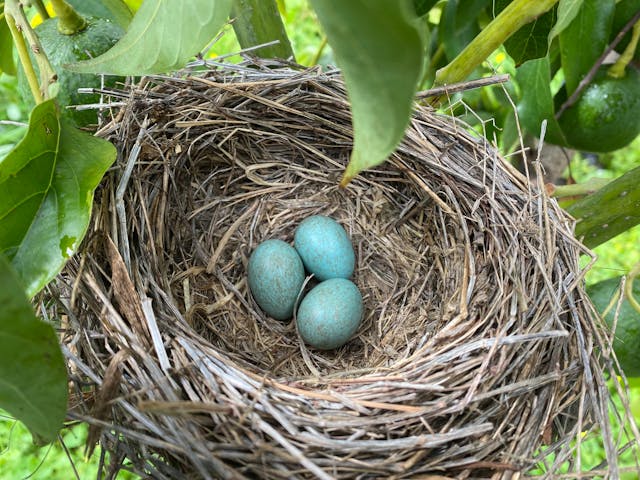
Why are bird nests s strong? The way that birds build nests depends very much on the birds. Different birds use different materials, different methods, and some birds don’t even build nests at all. However, the nests that birds build in trees tend to be strong because of their saliva.
Birds that don’t build nests generally either use an existing feature, or it is impractical for them to make a nest. An example of the latter is penguins. They need to be able to move to keep warm and if they were stuck to a single nest, they would probably die of cold. They incubate their eggs by holding them between their feet and their lower bellies. When the weather is particularly harsh, all of the penguins groups together to insulate themselves, constantly changing who is on the outside and who is in the middle. Some birds that don’t build nests do so because there is nowhere for them to build a nest. Peregrine falcons use a depression in the rocks to lay their eggs in, but they live at altitudes and on rock faces where there aren’t so many trees. Some birds use holes in trees and some birds burrow into the ground or into soft cliff faces. We’re going to focus on the birds that actually make nests though.
A nest has to serve several functions. It has to be high up so that it is out of the reach of predators, but not so high up that it can be seen from the air. It needs to be sturdy enough so that it won’t get blown out of the tree by strong winds. It needs to be big enough to hold the eggs of the bird and the chicks until they are big enough to fly away. And it has to be built out of available materials. Those materials vary from place to place, but they are generally materials that can be found in the springtime. Birds build nests so that they can safely lay eggs and rear them until they are big enough to fly away on their own. To do this, the nest needs to be insulated so that they can keep the correct temperature. Rearing a chick takes a different length of time for different sized birds, but it is usually about five weeks from laying the eggs to the young birds leaving the nest. This is how long the nests have to last for. Nests are sometimes made to last just one season, but a lot of nests are so strong that they can last several years. New generations of birds use the nests that their ancestors built. Some birds will pull a nest apart and start again, presumably to get rid of parasites. Some birds will remove the inner part, but leave the frame. And some birds will just use a nest as is. Some birds, such as cuckoos, use nests that they haven’t built themselves.
The location of the nest is sometimes on trees, but it can be on phone poles, in the eaves of buildings, or anywhere really. So long as it is high, hidden, protected from the elements, and the nest material will stick to it, the birds will build there. Obviously, birds do not have hands, so they are limited to materials they can pick up with their beaks. The larger the bird, the larger the material it can pick up and use in its nest. They generally begin with sticks, which are the most plentiful thing around trees. They start with laying lots of small twigs on top of each other to make the nest shape. Some of them they weave in and out for stability. Then they stick all of the twigs together using saliva. Bird saliva is literally the glue that makes bird’s nest so strong. Bird saliva is very thick and gelatinous, making it very easy for them to coat on sticks and twigs. When the saliva is exposed to the air, the water evaporates, leaving a solid, plastic like structure. It sets in pretty much the same way that wood glue does. In fact, bird saliva is a delicacy in some countries. You may have heard of bird nest soup, but it is actually bird saliva soup. They pick out all of the bits of wood, and then boil the solidified bird saliva.
Once the birds have used their saliva to set the frame, they add other things. Recently, more and more nests have bits of plastic and other trash in them. Some birds line the nest with moss and leaves to insulate it. The problem with moss, though, is that it absorbs water, so it is not good in areas of heavy rainfall. Some birds also use their own feathers to line the nest as well. This keeps it warm and insulated. So, thanks to a combination of materials, insulating things like feathers, and bird spit, bird nests are very strong and wamr. And this is what I learned today.
Sources
https://en.wikipedia.org/wiki/Bird_nest
https://www.nhm.ac.uk/discover/why-do-birds-nest.html
https://www.discoverwildlife.com/animal-facts/birds/bird-nests-guide
Photo by Aitor Larumbe Zabala: https://www.pexels.com/photo/eggs-in-nest-16633445/
